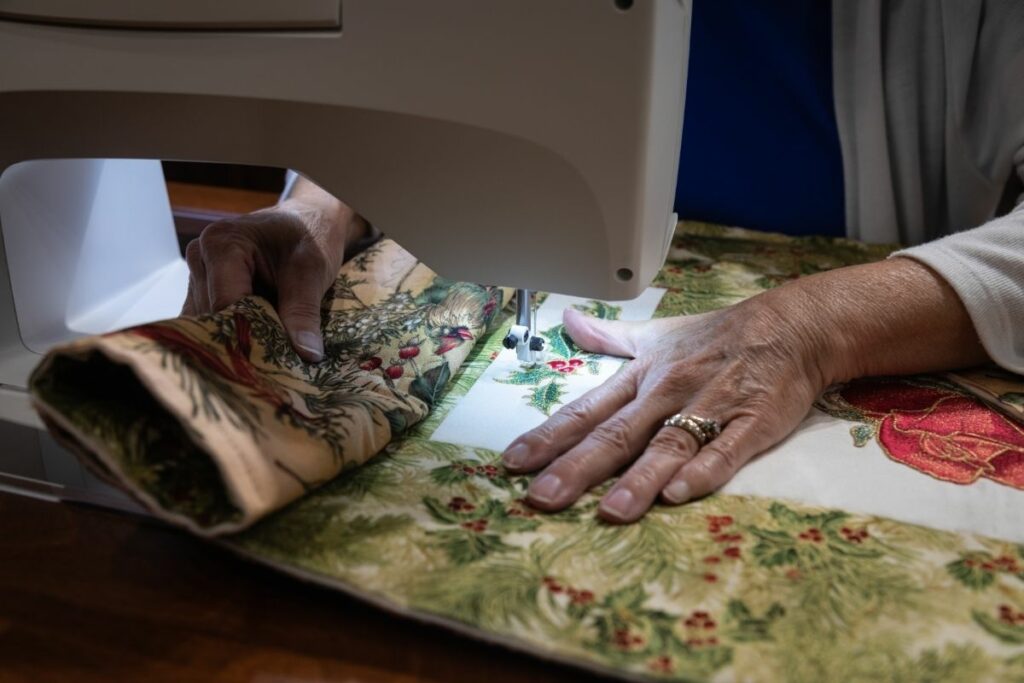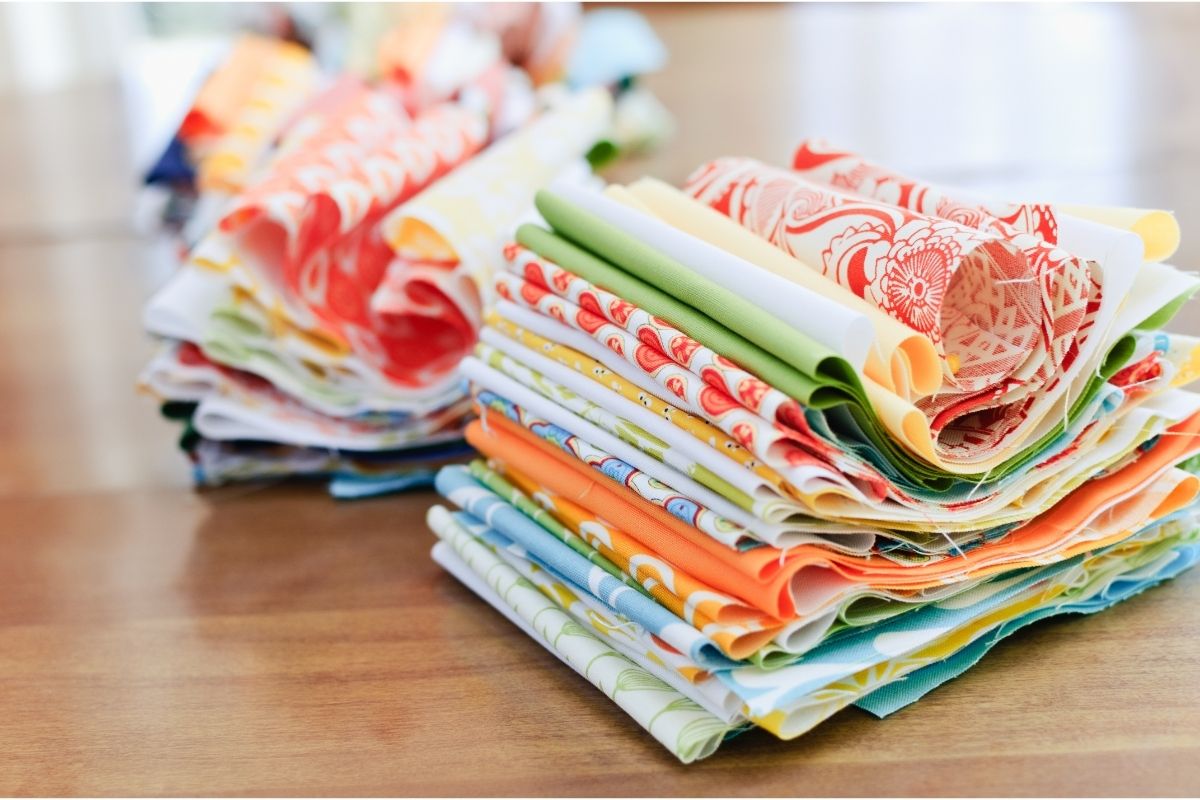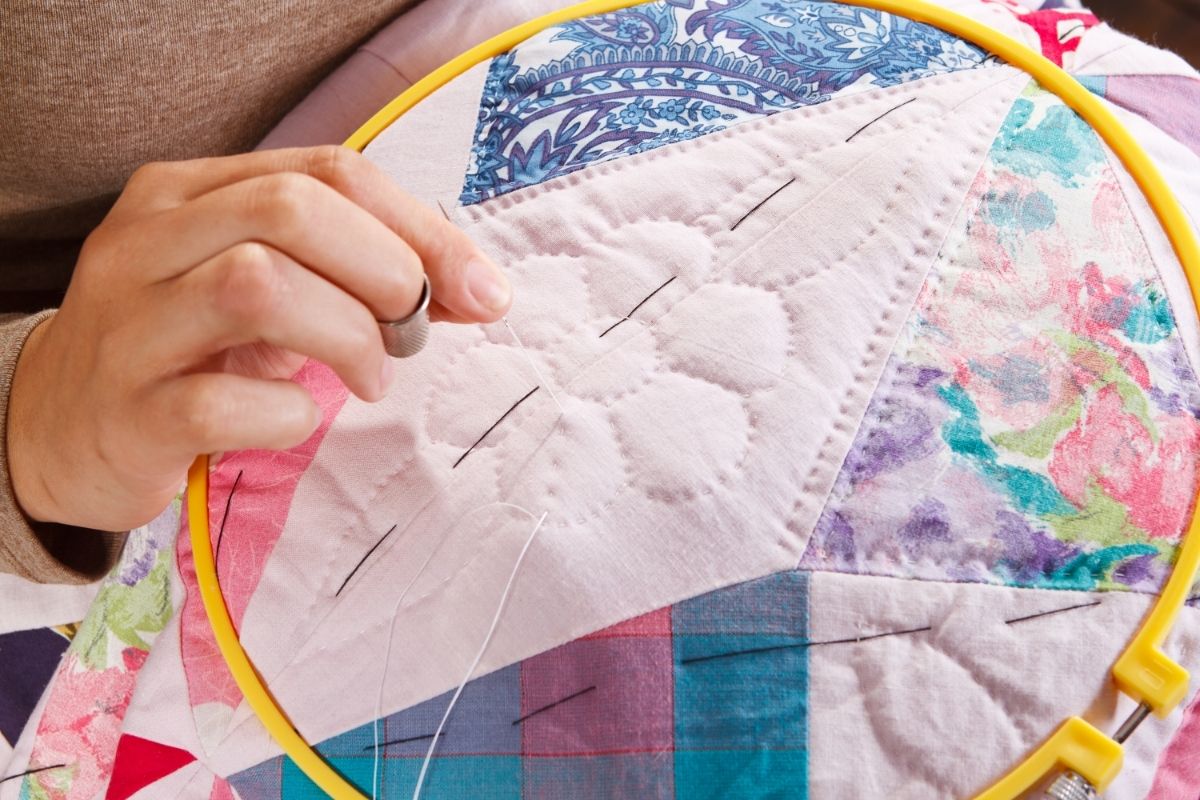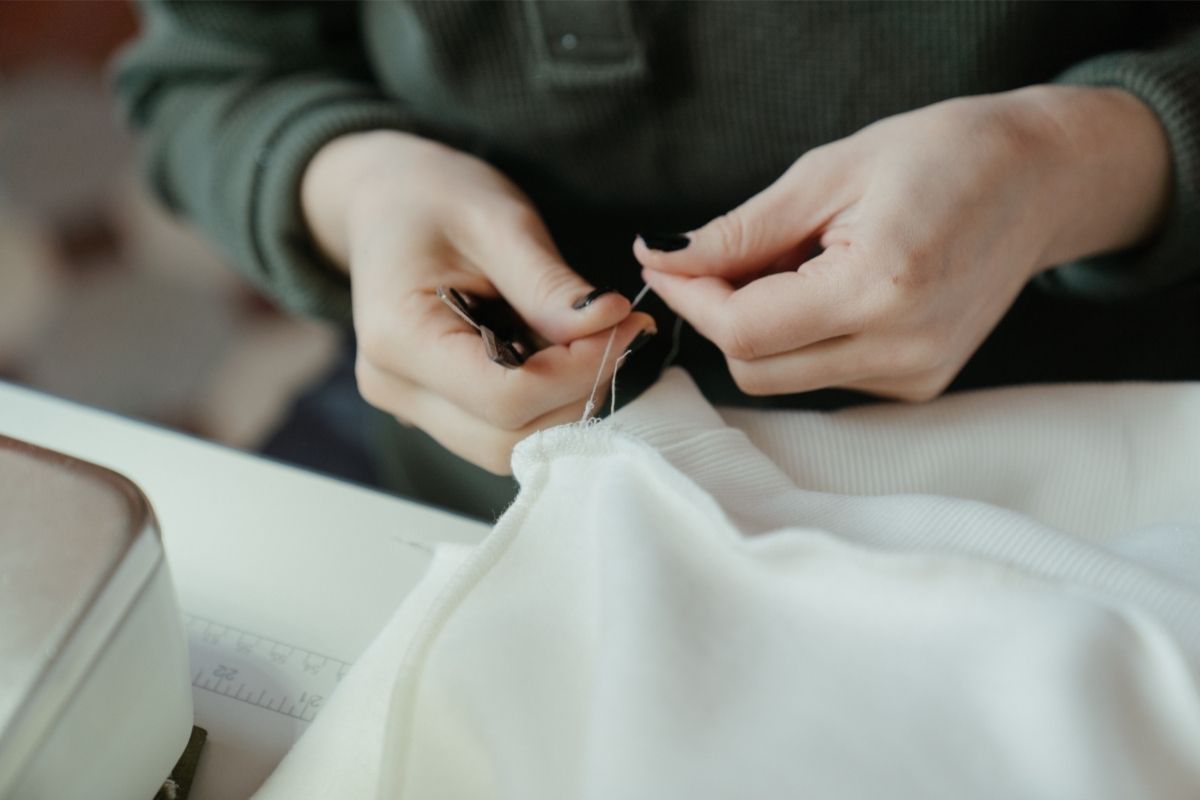The process of tying a quilt is one of the easiest and quickest ways to finish a quilt, and involves using thread or yarn to attach all layers (three of them) of a quilt smoothly together.
The most typically used way to tie a quilt is by using yarn, but there are lots of other modern alternatives that are worth keeping in mind when it comes to the best tying methods.

Therefore, in this guide we’ll take a closer look at seven of the most effective ways to tie your quilt at home. What’s more, we’ll also look to answer a number of the frequently asked questions.
Placement Of Quilt Ties
Deciding the distance you want the ties apart is essential before you begin the quilt-tying process. This is usually dependent on the kind of batting you’re using, as well as your desired quilt pattern.
Make sure you carefully check the label on the quilt batting as this will inform you on the amount of space possible to leave between stitching.
The vast majority of battings are relatively generous with their spacing, allowing anything from six inches up to 10 inches.
If, however, you’re tying your quilt, it’s probably best to leave a distance of no more than five inches due to the fact that the ties aren’t as dense as quilting stitches.
A good way to mark where you want your ties to go is to use a water-soluble pen.
Once you’ve decided on the space that you’re going to leave between the ties, inspect your quilt pattern and decide where the ties will appear the best.
The most usual spot is in the middle of the patchwork squares, but you can do whatever looks best to you.
Choosing The Right Thread Or Yarn
Before we go into some of the best methods to tie a quilt, it’s crucial to think about the thread and/or yarn you’ll be using, as well as where you want the ties to go.
When choosing thread or yarn, the first thing to consider is whether the fiber dye will seep into your quilt. If you’re concerned about this, try putting your thread or yarn in a bowl of warm water with a piece of white fabric to see how it reacts.
Needless to say, if the thread or yarn bleeds in the hot bowl of water, it’s a good idea to choose another fiber.
Another crucial consideration is the sort of material used to make your thread or yarn. When tying quilts, polyester or cotton thread is preferred, while yarn can indeed be made from synthetic or natural fibers.
While synthetic fibers such as acrylic and polyester are stronger and more resilient, their slick nature makes them more likely to come untied. Natural fibers, on the other hand, have a softer feel but can shred more easily than synthetic threads.
1). Satin Stitch With Embroidery Floss
The first unique way to tie a quilt we’ll take a closer look at is the satin stitch. This technique is commonly used in embroidery and ideal if you’re looking to give your quilt a modern, funky look.
There are lots of different ways you can use a satin stitch. For example, some people use a satin stitch in a patchwork block’s corner, whereas others prefer to turn their satin stitch into various shapes like rectangles or circles to give their quilt an even more interesting appearance.
Simply enter your needle and embroidery floss into the quilt from behind, then sew back down into the top of the quilt about 12 inch away to make a satin stitch. Replace the original stitch with a new one and repeat the process.
2). Fishbone Stitch With Embroidery Floss
Another unique way to tie your quilt is to use a fishbone stitch with embroidery floss. While this technique is a little more complex than many of the others on this list, it’ll provide your quilt with an excellent texture, and is perfect for creating a leaf shape.
You can either use a few stitched leaves throughout your quilt or use a fishbone stitch for every tie. Either way, this technique will definitely add a special touch to your quilt.
3). Star Stitch With Embroidery Floss
This unique decorative stitch requires only some embroidery floss and a needle. To create the stitch, insert the needle into the back of your quilt and then insert it back down into the fabric roughly ½ inch away. Repeat this in a clockwise circular pattern three more times.
To provide your quilt with some added interest, it might be a good idea to vary the sizes of your star stitches and include some clusters around your quilt. What’s more, if you’re feeling really adventurous, you can even attempt a couple of the well-known constellations.
4). X-Shape With Embroidery Floss
This technique is cute, modern, and incredibly easy to do, as all you need is some embroidery floss or 12 weight thread. If you decide to use embroidery floss, you have the ability to choose the number of threads you can use.
Begin by creating the first half of the X. You can do this by stitching into the quilt from the back, before stitching diagonally across to the top. Make sure you pull the thread firmly through and leave a tail of roughly two inches.
To complete the X-shape, simply repeat this process, but in the opposite direction. You can tie the threads together if you want to give your quilt a fresh take, while you can also bury the threads into the quilt if you want them to remain hidden.
5). Tassel With Yarn

If you want to give your finished quilt a touch of flair, tassels are the perfect choice. They might be a little messy and full-on for some people, but they’re certainly a unique tying method that’s worth considering.
6). Pom Pom With Yarn
To provide your quilt with some added texture, tying it with poms poms is an excellent idea. Simply stitch both of the pom’s tails through all three layers of the quilt, then double knot the ties on the back and cut the tails to the length you choose.
It’s worth noting that if you’re looking to create a number of pom poms, a pom maker is a solid investment. This way, you’ll be able to make perfect, evenly-sized pom poms every time.
7). Hidden Tie With Yarn
The final unique way of tying a quilt we’ll take a closer look at, and by certainly no means the least, is the hidden tie technique. If you’re someone who doesn’t like the mess associated with tying a quilt with yarn, this method will be ideal as it keeps all your ties hidden beneath the quilt.
The Traditional Quilt-Tying Method
While this guide has mainly focused on seven unique ways to tie a quilt, it’s also worth considering the traditional method. This is done using yarn, with wool or acrylic being the most popular choices.
Yarn-tied quilts provide a well-textured, bulky tie. However, it’s worth noting that these ties can sometimes come undone in the wash, therefore it’s vitally important that you carefully inspect your quilt after washing.
Listed below is a quick step-by-step guide on how to successfully tie a quilt using the traditional method:
- Start by threading your needle. It’s a good idea to use a long length of yarn to avoid having to constantly re-thread the needle.
- Then, stitch into the fabric from the top of the quilt. Make sure all three layers of the fabric are punctured, and then stitch through the back of the fabric roughly ½ inch away from where you first stitched through.
- Pull the thread through your quilt until you have a tail of two inches. Then, cut the thread that’s attached to the needle to get another two-inch tail.
- Double knot both the tails together and then trim them to your desired length.
- Finally, repeat this process until your entire quilt is fully tied together.
Frequently Asked Questions
What Is The Minimum Distance Apart That Ties Need To Be?
In general, the minimum distance apart for tying a quilt is 2 inches. With this in mind, it’s important that you make sure there’s enough space between each piece of fabric to avoid them becoming tangled up when you’re sewing them together.
How To Wash A Quilt Safely?
First, put the quilt into the washing machine on the gentle cycle and add ½ cup of mild detergent per load of wash water. Make sure you rinse the quilt thoroughly after every wash.
It’s worth noting that you should avoid dry cleaning and ironing a quilt as this can damage the fabric. Furthermore, always store a quilt flat when not in use and keep a quilt cover on hand if you’re planning to travel with your quilt.
What Is Pearl Cotton Thread Used For?
Pearl cotton thread is used for embroidery projects such as cross stitching, appliquéing, and needle pointing. This particular thread provides a soft feel and comes in a variety of colors.
How Do I Know Which Size Needle To Use On My Machine?
The most effective way to determine the correct needle size is to measure the entire circumference of the desired project. Once you’ve done this, multiply that measurement by three and round up to the nearest whole number. This should give you the appropriate needle size.
What Is The Easiest Quilt Pattern For A Beginner?
It’s difficult to say for definite which is the easiest quilt pattern for a beginner to use, due to the fact that every person has a different set of skills and preferences. However, listed below are a few pattern ideas that might be useful when it comes to choosing a simple and suitable pattern for your quilt.
- Square Patchwork – this pattern is easy to understand and follow.
- Strips – this pattern is pretty much the same as squares, but strips are even easier to work with.
- Picot Edge – this pattern is similar to square patchwork, but can add a little more interest.
How Can You Tie A Quilt Using Buttons?
- Start with an even number of rows or columns
- Use at least one button in each row
- Make sure that all your ties have the same length (use a ruler to help)
- If you want to add more than one color, start by making one color first
- When you get tired of tying, simply cut off the excess thread
- Make sure you don’t forget to put the needle through the back loop before sewing on the next row
- To keep things neat, sew the last row to the top of the previous row
- After you’ve finished sewing, remove the pins and then fold the edges under, so they won’t show
- Finally, don’t forget to press!
How Many Ways Are There To Sew A Quilt?
There are a variety of different ways to sew a quilt. Some people prefer to hand stitch their quilts, while others like to machine sew them. Whichever method you choose, there are several techniques to learn. Listed below are some important tips to keep in mind.
- Practice makes perfect
- Start out slowly and gradually increase the speed as you gain confidence
- Be patient and avoid becoming frustrated
- Take time to enjoy and appreciate your work
The Bottom Line
To conclude, there are lots of unique ways to tie a quilt if you’re looking for something a little more interesting. Whether you’re using yarn or embroidery floss, both fabrics can be used in a variety of different ways, providing your quilt with a beautiful finishing touch.
Hopefully, after reading the information in this guide, you’ll be in a much better position to decide which tying techniques are best for your quilt – good luck!
- How to Cut Quilt Pieces - April 25, 2022
- Your Simple Guide To Quilt Sizes - April 25, 2022
- How To Join A Quilt With Diagonal Seam - April 25, 2022







